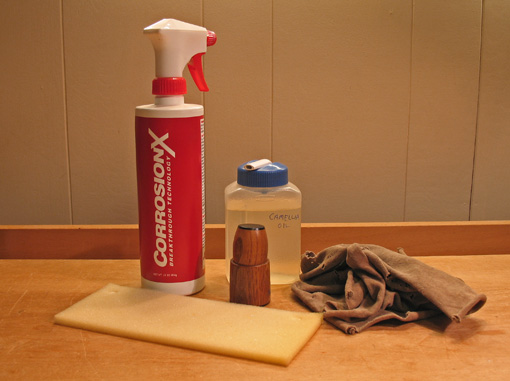In general, I have nothing against oxygen; I use it on a regular basis. I just do not like its predilection to hook up with the iron in my tools. Like all tool folk, I hate rust. Hoping to prevent this unholy molecular union, I’ve tried many methods and products over the years. Here are the proven performers: three non-toxic, virtually problem-free products.
Camellia oil. This gets wiped onto all my hand edge tools and some steel measuring tools with either an oily rag or an oil rub, a wad of soaked felt in a wooden cup. This very light oil has a pleasant fragrance, and only a minimal film is required to prevent rust. I’ve never had any problems with the oil interfering with gluing or finishing since I use a quick cleaning wipe on edge tools before putting them to wood. Freshly sharpened tools get oiled promptly after the water is wiped off, but I make sure oil stays away from my Shapton stones. One 8 ounce bottle lasts a few years for me.
Corrosion X. I use this on cast iron machinery surfaces and for other power tool applications. I much prefer it to the several other products I’ve tried, including Boeshield and Top-Cote. I wipe it on and rub it in infrequently, when I think of it, perhaps every few months. The manufacturer claims Corrosion X is non-toxic, non-carcinogenic, nonflammable (in the pump spray form), has no silicon, and has only 8.6% VOC. I find it has only a mild odor.
Bull Frog Vapor Corrosion Inhibitor. This is a yellow foam pad, about 10 inches square, containing the non-toxic, odorless VCI chemical which settles on metal in an invisible layer only a few molecules thick. The pad is rated to protect 50 cubic feet of enclosed space. I cut it into several proportionate size pieces to protect the contents of various tool cabinets and boxes. This is cheaper than buying smaller strips. It lasts at least one year and works well without a hint of problems.
Here in the Northeast US summers can get very humid. An electric dehumidifier in the shop keeps humidity moderated for the sake of my tools as well as the wood.
This multi-pronged approach has kept rust at bay in my shop. I hope it helps in yours. Go Rust Busters!



I suggest that lanolin (sheep grease) is even better and is absolutely natural. Have a look at http://www.lanotec.com.au. It keeps all my tools rust free in the humidity of coastal Australia
Rob,
Where did you find your Camellioa oil applicator pictured? I’m able to find the oil easily enough, but I always see people with the special applicators and I don’t know where to get them or exactly how to best make my own.
Ethan
Jeremy,
Thanks for the suggestion. I couldn’t find anything on the site about sales to or in North America. Maybe one of the tool vendors in the US will pick it up since it sounds like a good product line.
This sort of information exchange around the globe is one of the wonderful things about the internet and blogging. Thanks.
Rob
Ethan,
I got that oiler about 20 years ago. It’s no longer available. It is smaller than I’d like so I’ve been thinking of making a new one.
Here’s what I think I’d try. Using a 1 1/2″ or 2″ bit, carefully drill about 2″ into the end grain of a 3″ tall block. Seal the inside, especially the end grain, with epoxy to prevent oil from bleeding through. Stuff the inside with tightly rolled and bound cotton or felt, allowing about 1/2″ of the roll to protrude.
The outside of the cup could be shaped into a cylinder, or better yet, a slight cone. For protection, the cone could partially fit into another cup, either shop-made or just from around the house.
Good luck if you try this. I’d be interested in how it works out if you’d like to let me know.
Rob
Two more things:
Also, the traditional Japanese method to make an oiler is to use a length of bamboo with a knuckle near the bottom. Toshio Odate describes this in his book Japanese Woodworking Tools. My suggestion is just an adaptation of his method but with wood.
By the way Jeremy, the lanolin must be very effective. I’ve never seen a rusty sheep. (Couldn’t resist that, sorry.)
Rob